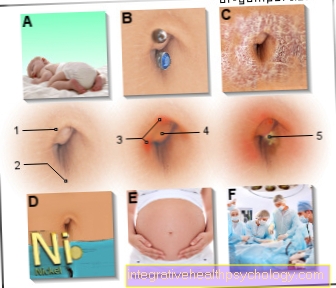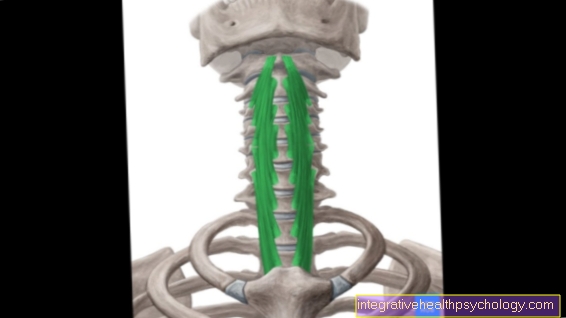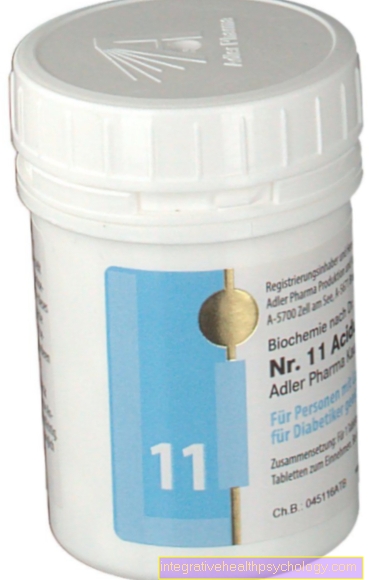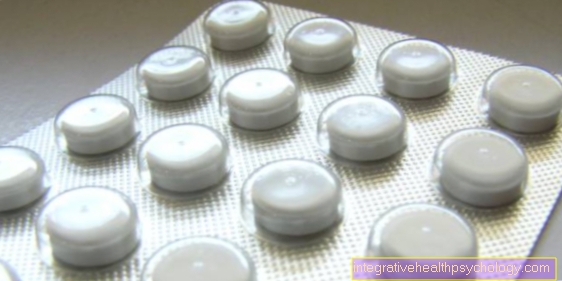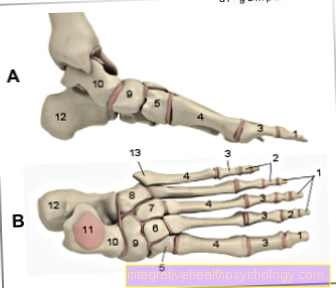Lung biopsy
What is a lung biopsy?
A lung biopsy is taking a sample of tissue from your lungs. It is mainly taken via a bronchoscopy (lung specimen), transthoracic (through the thorax) fine needle biopsy or thoracoscopy (surgical procedure through the chest cavity) using a hollow needle or biopsy forceps. Which method is used depends on the location of the suspicious area in the lungs.

Indications for a lung biopsy
The general indication for a lung biopsy is the clarification of lung diseases that cause clinical symptoms and can be detected in a radiological procedure, but the cause is unclear. These include above all lung tumors, interstitial lung diseases (for example pulmonary fibrosis), silicosis (occupational disease of the lungs caused by quartz dust) or exogenous allergic alveolitis (caused by organic dust).
Prepare for a lung biopsy
Before doing a lung puncture, it is important to watch out for blood clotting. The attending physician will discuss with you whether the medication you are taking regularly contains anticoagulant medication and whether it can be continued or must be paused. As a rule, ASA can still be taken. If you take ASA and clopidogrel in combination, it is usually recommended to pause clopidogrel 5 days beforehand.
The INR (a laboratory blood test for blood clotting) should be checked when taking Marcumar. As a rule, this should be less than 1.5 for a lung puncture.
It should also be noted that painkillers belonging to the NSAID group also have an anticoagulant effect. Aspirin and ibuprofen should therefore, if possible, not be used to treat pain. Here it is recommended to take paracetamol, which does not affect blood clotting.
You should be sober on the day of the lung biopsy. This means that the last meal can be consumed on the evening before the lung biopsy and only clear liquids such as water or tea can be drunk up to around 4 hours before the biopsy.
To calm you down, you can be given a sedative before the lung biopsy. If necessary, you can still receive a little oxygen through a nasal cannula or, if you are coughing, cough suppressants.
Procedure for a lung biopsy
The process differs according to the methods used.
-
Lung biopsy via bronchoscopy
With a lung biopsy using a bronchoscopy, the mouth and throat area is numbed with a spray. If necessary, something can also be given for sedation. The bronchoscope is inserted into the bronchi through the mouth or nose. It consists of a hose with a camera on the end. There is also a working channel through which a tissue sample can be taken from the lungs using biopsy forceps. The area is then rinsed with saline and suctioned off. -
Lung biopsy via a transthoracic fine needle biopsy
The transthoracic (through the chest) fine needle biopsy is usually performed by a radiologist who works interventionally. If possible, it is performed in the prone position. The area to be punctured is covered in a sterile manner and anesthetized with a local anesthetic. The biopsy needle is usually inserted into the suspicious region using an ultrasound machine or a CT scan. You will be asked to hold your breath during the puncture. After the procedure, an X-ray of the chest will be taken to rule out pneumothorax (air in the gap between the two lungs) and bleeding. -
Lung biopsy via thoracoscopy
Thoracoscopy is one of the minimally invasive surgical procedures. During a thoracoscopy, instruments and a camera are inserted through the chest cavity through a small incision. These can be used to take tissue samples from the lung tissue. The area is then rinsed and vacuumed. The incision is sewn up and a plaster bandage is put on. A drain is also inserted for 1-2 days. After pulling the drainage, an X-ray of the chest is made for control purposes. Thoracoscopy is usually performed under general anesthesia. Sedation is also possible.
How painful is a lung biopsy?
Depending on which method is used, a lung biopsy is painful differently. In general, one can say that a lung biopsy is a little painful procedure.
The bronchoscopy should not usually cause pain. The mouth and throat are adequately numbed and the lung tissue sample is usually not painful. Of course, it can still lead to slight pain and an uncomfortable feeling. Pain medication can be given at any time if necessary.
In the transthoracic fine needle biopsy, the skin and muscles in the area to be punctured are numbed with a local anesthetic. The tissue sample itself is usually not painful either. Of course, slight pain or an uncomfortable feeling can still arise. A pain reliever can be taken at any time if necessary or if pain occurs afterwards.
Since a thoracoscopy is preferably performed under general anesthesia, it is usually not painful either. Most of the time, the pain relievers that are given during anesthesia will work for a while after the anesthesia so you shouldn't feel any pain. If you experience pain in the recovery room or on the ward, you can always ask for a pain reliever.
Do you need anesthesia for a lung biopsy?
A lung biopsy via bronchoscopy or fine needle biopsy is usually done without anesthesia. The mouth and throat area is numbed with a bronchoscopy with a spray. With a fine needle biopsy, the area to be punctured is numbed with a local anesthetic. In addition, tranquilizers or sedation can be given.
A lung biopsy via a thoracoscopy is usually done under general anesthesia. If necessary, this can also be carried out in his sedation.
evaluation
The tissue sample is sent through to pathology or special laboratories. Histological, cytological, immunological or genetic tests can be carried out here.
Your doctor will explain to you beforehand which tests will be carried out. For genetic testing in particular, prior information must be provided.
Depending on which tests are carried out, the result also takes different lengths of time. The results from the pathology are usually available within a few days.
What are the risks?
A lung biopsy is generally a low-risk procedure. However, bleeding or a pneumothorax (air between the two lungs) can occur. Therefore, the coagulation values are checked before the lung biopsy in order to minimize the risk of bleeding.
A pneumothorax can occur, especially with a transthoracic lung biopsy. Therefore, an X-ray is then made for control.
In rare cases, an infection can occur. During a transthoracic lung biopsy or a fine needle biopsy, the skin is disinfected, the surrounding area is covered with sterile covers and sterile materials are used to avoid possible infections as far as possible.
How long does a lung biopsy take?
A lung biopsy takes different lengths of time depending on which method is used. As a rule, you should expect 5 to 30 minutes. In addition, there is the preparation and follow-up, which usually takes more time than the biopsy itself.
Lung biopsy costs
The bronchoscopy with surgery costs 52.46 euros according to the simple rate of the fee schedule for doctors. The factor can be increased by 2-3 times. In addition, there are other material costs.
Who bears the costs?
As a rule, the health insurance company bears the costs for a lung biopsy, as this is only carried out by a doctor if indicated.
Are there alternatives?
There are no alternatives that provide evidence of an underlying disease. Imaging tests such as an MRI of the lungs or CT of the lungs can only provide clues about an underlying condition.








-mit-skoliose.jpg)

